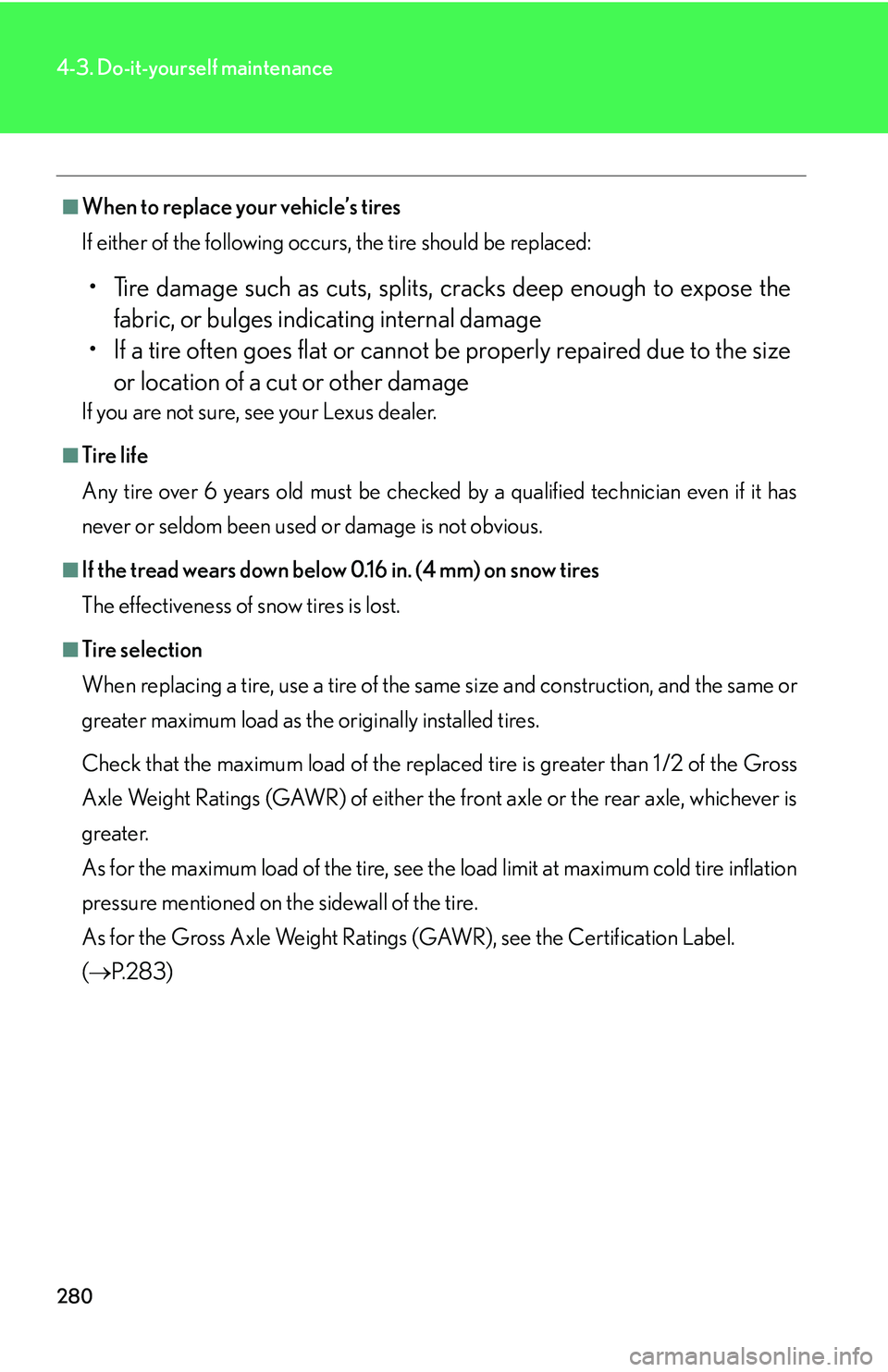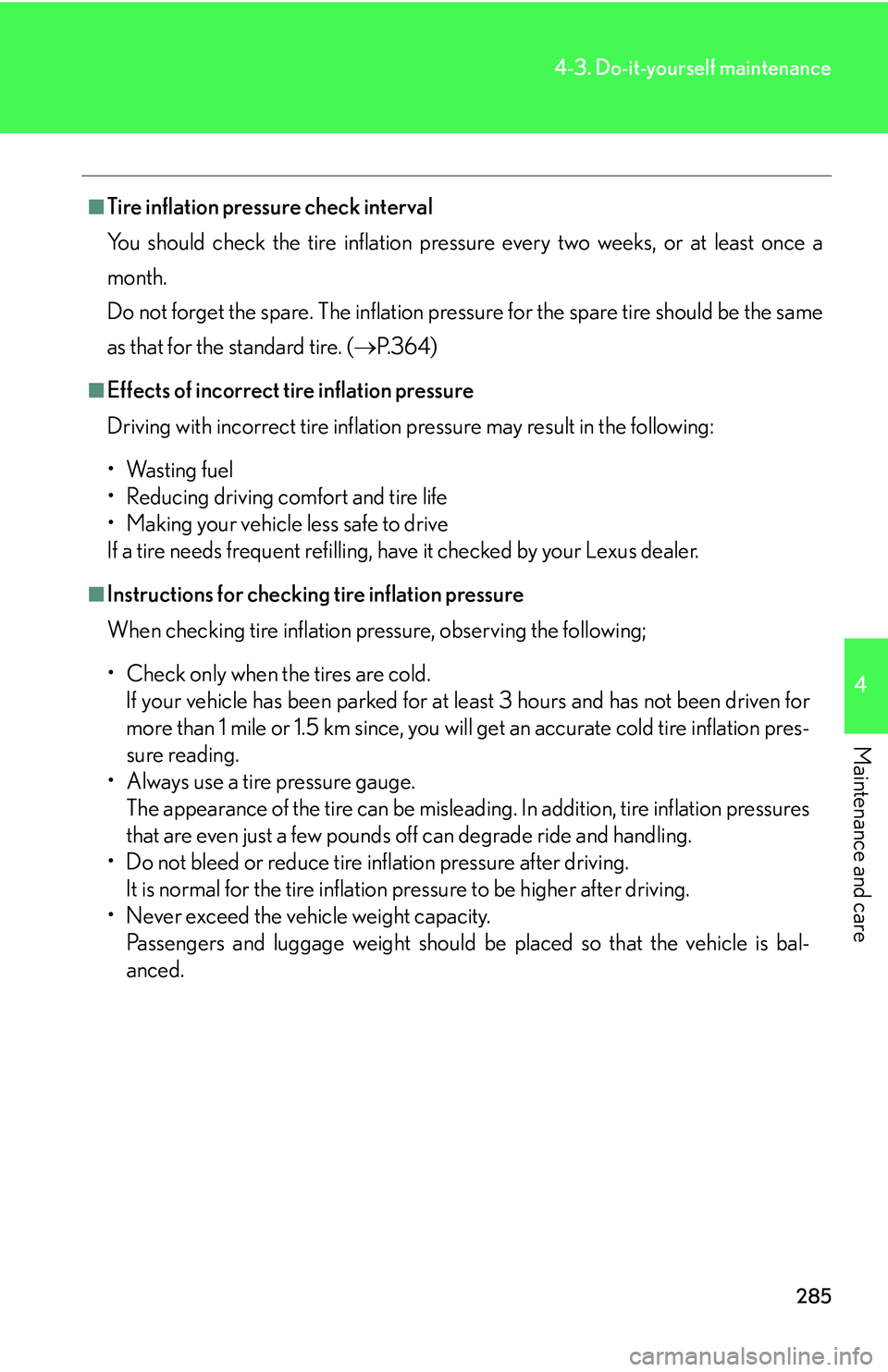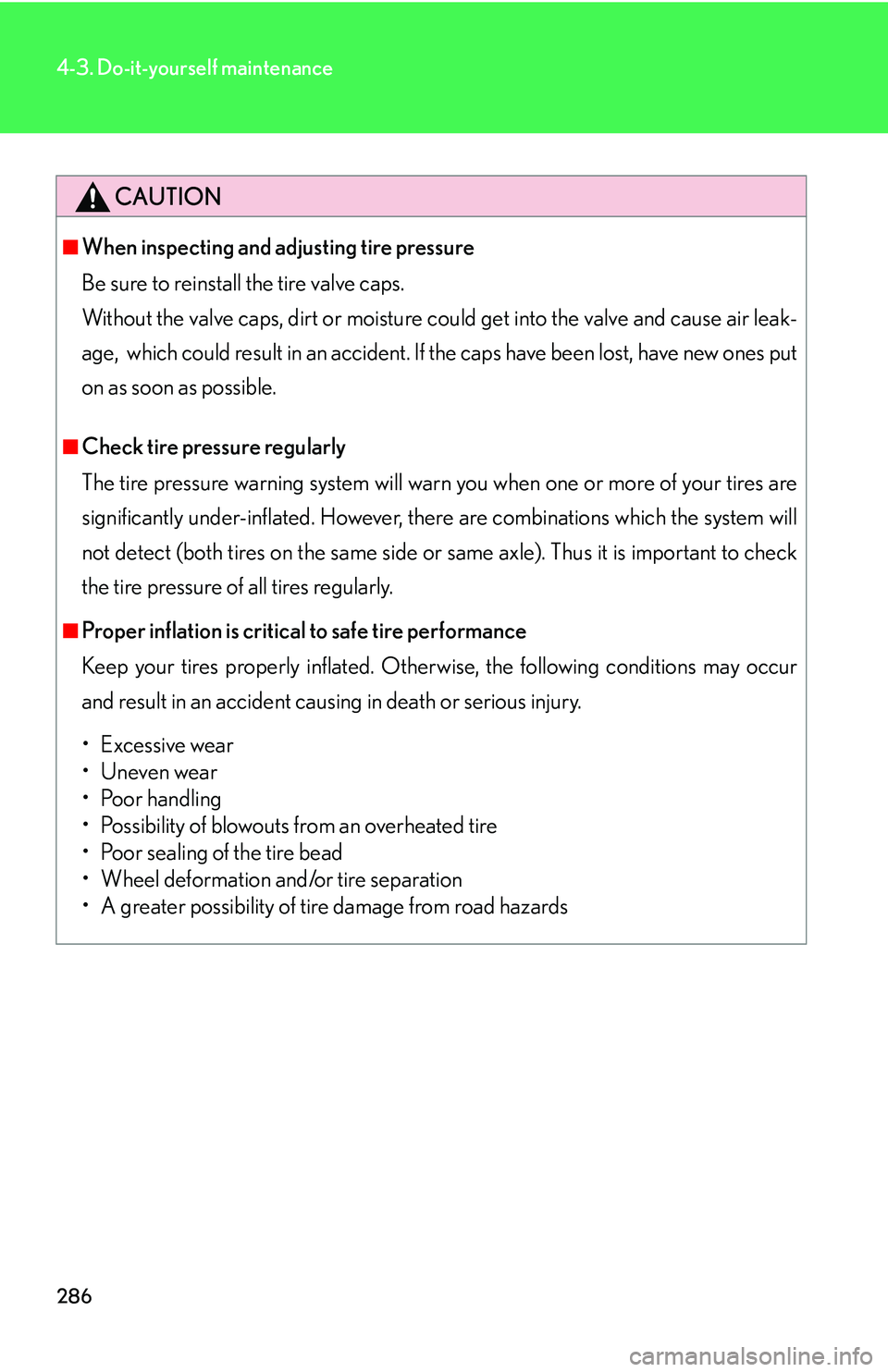Page 296 of 419

280
4-3. Do-it-yourself maintenance
■When to replace your vehicle’s tires
If either of the following occurs, the tire should be replaced:
• Tire damage such as cuts, splits, cracks deep enough to expose the
fabric, or bulges indicating internal damage
• If a tire often goes flat or cannot be pr
operly repaired due to the size
or location of a cut or other damage
If you are not sure, see your Lexus dealer.
■Tire life
Any tire over 6 years old must be checked by a qualified technician even if it has
ne
ver or seldom been used or damage is not obvious.
■If the tread wears down below 0.16 in. (4 mm) on snow tires
The effectiveness of snow tires is lost.
■Tire selection
When replacing a tire, use a tire of the sa me siz
e and construction, and the same or
greater maximum load as the originally installed tires.
Check that the maximum load of the replaced t
ire is greater than 1 /2 of the Gross
Axle Weight Ratings (GAWR) of either the front axle or the rear axle, whichever is
greater.
As for the maximum load of the tire, see the load limit a
t maximum cold tire inflation
pressure mentioned on the sidewall of the tire.
As for the Gross Axle Weight Ratings (GAWR), see the Certification Label.
( P.283 )
Page 298 of 419
282
4-3. Do-it-yourself maintenance
+
CAUTION
■When inspecting or replacing tires
Observe the following instructions, as failure to do so may cause dangerous han-
dling characteristics resulting in loss of contr
ol and could cause death or serious
injury.
• Do not mix radial, bias belted, or bias-ply tir
es on your vehicle, or use tires other
than the manufacturer’s recommended size.
• Do not mix summer and all season tires on your vehicle.
• Do not use tires other than the manufact ur
er’s designated tires, and never mix
tires or wheels of different size to the originals.
NOTICE
■To prevent malfunction of the tire pressure warning system
Do not push the reset switch without adjusting the tire inflation pressure to the spec-
ified level. Otherwise, the low tire pressure warning may not function correctly.
( P.334 )
■If tire pressure becomes low while driving
Do not continue driving, your ti r
es and/or wheels may be ruined.
Page 299 of 419
283
4-3. Do-it-yourself maintenance
4
Maintenance and care
Tire inflation pressure
■Tire inflation pressure
The recommended cold tire inflation pressure and tire size is displayed on the
tire and loading information label.
Recommended cold tire inflation pressure
Ti r e s i z eInflation pressure psi (kPa, kgf/cm2 or bar)
P225/55R17 95HFront32 (220, 2.2)
Rear32 (220, 2.2)
245/45R18 96WFront33 (230, 2.3)
Rear33 (230, 2.3)
P245/45R18 96VFront33 (230, 2.3)
Rear33 (230, 2.3)
Page 300 of 419
284
4-3. Do-it-yourself maintenance
For sustained high speeds above 100 mph (160 km/h), in countries where such
speeds are permitted by law, add the below pressure to the front tires and rear
tires, but never exceed the maximum cold tire inflation pressure molded on the
tire sidewall.
• P225/55R17 95H: 3 psi (20 kPa, 0.2 kgf/cm2 or bar)
• 245/45R18 96W: 6 psi (40 kPa, 0.4 kgf/cm2 or bar)
• P245/45R18 96V: 6 psi (40 kPa, 0.4 kgf/cm2 or bar)
■ Inspection and adjustment procedure
Ti r e v a l v e
Tire pressure gauge
Remove the tire valve cap.
Press the tip of the tire pressure gauge to the tire valve.
Read the pressure using the graduations on the gauge.
If the tire inflation pressure is not within r
ecommended levels,
inflate the tire.
If you add too much air, press the center of the valve to lower.
After completing the tire inflation pressure measurement and
adjustment, apply soapy water to the v
alve and check for leakage.
Reinstall the tire valve cap.
1
2
Page 301 of 419

285
4-3. Do-it-yourself maintenance
4
Maintenance and care
■Tire inflation pressure check interval
You should check the tire inflation pressur
e every two weeks, or at least once a
month.
Do not forget the spare. The inflation pressure for the spare tire should be the same
as
that for the standard tire. ( P.364 )
■Effects of incorrect tire inflation pressure
Driving with incorrect tire inflation pressure may result in the following:
•Wasting fuel
• Reducing driving comfort and tire life
• Making your vehicle less safe to drive
If a tire needs frequent refilling, have it checked by your Lexus dealer.
■Instructions for checking tire inflation pressure
When checking tire inflation pressure, observing the following;
• Check only when the tires are cold.
If your vehicle has been parked for at least 3 hours and has not been driven for
mor
e than 1 mile or 1.5 km since, you will get an accurate cold tire inflation pres -
sure reading.
• Always use a tire pressure gauge.
The appearance of the tire can be misleadi n
g. In addition, tire inflation pressures
that are even just a few pounds off can degrade ride and handling.
• Do not bleed or reduce tire inflation pressure after driving.
It is normal for the tire inflation pressure to be higher after driving.
• Never exceed the vehicle weight capacity.
Passengers and luggage weight should be pla
ced so that the vehicle is bal-
anced.
Page 302 of 419

286
4-3. Do-it-yourself maintenance
CAUTION
■When inspecting and adjusting tire pressure
Be sure to reinstall the tire valve caps.
Without the valve caps, dirt or moisture c
ould get into the valve and cause air leak-
age, which could result in an accident. If the caps ha
ve been lost, have new ones put
on as soon as possible.
■Check tire pressure regularly
The tire pressure warning system will warn you when one or more of your tires are
si
gnificantly under-inflated. However, ther e are combinations which the system will
not detect (both tires on the same side or same axle). Thus it is important to check
the tire pressure of all tires regularly.
■Proper inflation is critical to safe tire performance
Keep your tires properly inflated. Otherwise, the following conditions may occur
and r
esult in an accident causi ng in death or serious injury.
•Excessive wear
• Uneven wear
• Poor handling
• Possibility of blowouts from an overheated tire
• Poor sealing of the tire bead
• Wheel deformation and/or tire separation
• A greater possibility of tire damage from road hazards
Page 335 of 419
5When trouble arises
319
5-1. Essential information............ 320If your vehicle needs to be
towed .......................................... 320
If you think something is
wrong.......................................... 324
Fuel pump shut off system ..... 325
Event data recorder................. 326 5-2. Steps to take in an
emergency ........................... 328
If a warning light turns on... ... 328
If a warning message
appears... ................................... 334
If you have a flat tire .................. 347
If the engine will not star
t....... 353
If the transmission selector
lever cannot be shifted
from P ......................................... 354
If you lose your keys................. 355
If the vehicle has a
discharged battery................ 356
If your vehicle overheats........ 359
If the vehicle becomes
stuck .............................................. 361
Page 340 of 419

324
5-1. Essential information
If you think something is wrong
If you notice any of the following symptoms, your vehicle probably needs
adjustment or repair. Contact your Lexus dealer as soon as possible.
■Visible symptoms
Look for any of the following symptoms.
• Fluid leaks under the vehicle
Water dripping from the air conditioning after use is normal
• Flat-looking tires or uneven tire wear
• Engine coolant temperature gauge needle continually points higher
than normal
■ A
udible symptoms
Listen for any of the following symptoms.
• Change in exhaust sound
• Excessive tire squeal when cornering
• Strange noises related to suspension system
• Pinging or other noises related to engine
■ P
roblems with operation
Check for any of the following symptoms.
• Engine missing, stumbling or running rough
• Appreciable loss of power
• Vehicle pulls to heavily one side when braking
• Vehicle pulls to heavily one sid e when driving on a le
vel road
• Loss of brake effectiveness, sp ongy feeling, pedal almost touches
floor